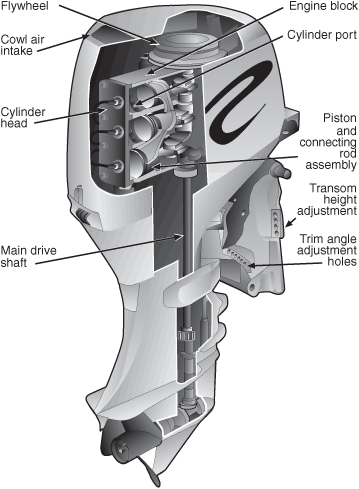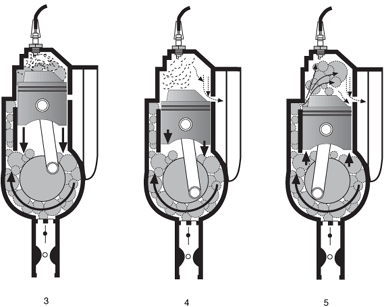
Before you can fix a sick engine, you have to know what makes a healthy engine run. The principle is pretty simple: A piston fits into each cylinder. When fuel explodes on top of the piston, the piston is forced to move in the only direction it can, down the cylinder. The piston, which is connected by a rod to a crankshaft, turns this downward motion into something more useful by rotating the crankshaft. The crankshaft, in turn, shoves the piston back up the cylinder for more action.
All outboard engines must:
• Admit a mixture of fuel and air.
• Compress that mixture.
• Ignite the compressed mixture.
• Clear away the burned gases.
Remember those four needs: fuel, compression, ignition, and exhaust. They'll come in handy when you're troubleshooting. And they're valid for all kinds of internal combustion engines, two-strokes and four-strokes; gasoline engines and diesels.
Two-stroke engines complete the full cycle of fuel induction, compression, ignition, and exhaust with just two strokes of the piston in the cylinder, one up and one down.
In four-stroke engines, the piston must travel up twice and down twice—four strokes in all—to complete the same cycle. The pay-off is that four-strokes are more efficient than two-strokes. Later, we'll discuss in more depth the relative advantages of two-stroke and four-stroke engines. Right now, what you need to know is that two-strokes are more powerful for their weight, so you get a lot of horsepower from a light engine. They're also mechanically simpler. But they are gas guzzlers and don't particularly like slow running. Their greatest sin is that they burn their lubricating oil along with the gasoline. This causes so much exhaust pollution that the U.S. Environmental Protection Agency (EPA) is forcing two-stroke outboard-engine manufacturers to reduce hydrocarbon emissions by 75 percent within the next 10 years. (You'll find more information about that in Chapter 11.)
Four-stroke engines are heavier, and usually costlier, because they need fuel-intake valves and exhaust valves. But they're more economical to run than two-strokes—they get far better mileage. Significantly, they're also much kinder to the environment. They don't burn their lubricating oil, so they pollute much less.
This book isn't meant to turn you into an engine overhaul specialist, so we don't need to go into great detail about your engine's insides. You do, however, need to know where the most important major components are situated. That will help later, when you learn to "listen" for trouble. If abnormal noises come from your engine some day, you'll know what part is acting up.
It may seem surprising, but regardless of what brand of outboard engine you have, its internal layout will be essentially the same as any other brand's. You will find differences, though, between two-stroke and four-stroke engine internal configurations.
Figure 1-1 shows a typical two-stroke outboard engine with all the major parts identified. Figure 1-2 shows a new four-stroke outboard. The latter looks (and in fact is) very much like a modern automobile engine tilted on end.
You'll note that one of the major differences between the two is that the four-stroke has valves on each cylinder: an intake valve to let the fuel/air mixture into the cylinder and an exhaust valve to allow the exhaust gases to escape. The opening and closing of these valves is controlled by a timing belt attached to the crankshaft.
This means, incidentally, that owners of four-strokes have some servicing tasks the two-stroke owner never has to deal with. One is the need for periodic inspection and replacement of the timing belt. Figure 1-2 shows how the belt connects the crankshaft (center) to the overhead camshaft (left) that, in turn, controls the valves.
Another maintenance task reserved for the four-stroke owner is to change the crankcase oil and filter
Figure 1-1. Cutaway view of a typical two-stroke outboard engine.
Figure 1-2. Cutaway view of a typical four-stroke outboard engine.
periodically—just as you do with your car. Two-stroke engines don't have crankcase oil, as we'll see later.
In addition, a four-stroke engine's valves will need adjustment now and then. A two-stroke gets along fine without valves—at the cost of reduced efficiency and increased pollution.
Don't worry if you haven't managed to absorb everything so far. It's not the detail we're studying here, just the basic principles. As you go through this book, the names and procedures will come up again, and you'll greet them like old friends. Meanwhile, take another look at Figures 1-1 and 1-2. They'll help you to visualize the parts mentioned.
Even today the vast majority of outboard engines are two-stroke engines. But with new engines, that is changing dramatically. The four-stroke is taking over so manufacturers can meet clean air requirements. My own dinghy motor is a perfect example. My 8 hp Tohatsu is quiet running and essentially smokeless and a four-stroke. Ten years ago four-stroke engines this size were only available from Honda. Today, they are the norm. Each configuration has its advantages and disadvantages, but four-strokes, with their cleaner emissions, are the standard today and we now see them in the smallest to the largest horsepower ranges available. In any case, to be an engine troubleshooter you need to know how both kinds of engine work.
Remember the four basic needs; they can't be stressed enough. Whether it's a two-stroke or a four-stroke, the engine needs a fuel/air mixture delivered to the cylinder; it needs to compress it; the mixture must somehow be ignited; and, when it's done burning, the exhaust gases must be removed. This process occurs repeatedly as the engine runs, and the order in which these things happen must be exact to within a fraction of a second.
It may help to think of an internal combustion engine as a pump of sorts. Let's take a look at Figure 1-3 to see how the four-stroke works:
Stroke 1—The piston travels down the cylinder, drawing the air-fuel mixture in behind it.
Stroke 2—On its way up again, the piston compresses this mixture to help make a more efficient explosion. (Incidentally, the piston rings stop the mixture from leaking out of the slight gap at the sides.)
Stroke 3—When it's nicely compressed, this mixture is ignited, and the resulting explosion forces the piston down the cylinder. The piston, as we've mentioned before, has a connecting rod attached to an offset on the crankshaft, and that forces the crankshaft to turn.
Stroke 4—So, finally, while the piston is being pushed back to its starting position by the revolving crankshaft, it's also pushing out the burned gases and preparing to start the cycle all over again.
Thus, the engine has converted the reciprocating (back-and-forth) motion of the piston into something more useful for driving a propeller: rotary motion.
Figure 1-4 depicts the two-stroke cycle. The significant difference here is the absence of conventional intake and exhaust valves. In fact, there are valves in a purely technical sense: The moving pistons alternately reveal and cover up ports (holes) in the cylinder wall, thus acting as valves. The ports are the means of gas entry and exit from the combustion chamber.
The other big difference is that the two-stroke engine actually combines the intake and compression strokes into one operation, and the power and exhaust strokes into another. As we've already seen, this enables it to complete all four necessary functions—intake, compression, ignition, and exhaust—with just two strokes of the piston in its cylinder, and only one revolution of the crankshaft instead of two.
Let's look at the sequence of events in Figure 1-4.
Diagram 1—The piston rises in the cylinder and compresses the air/fuel mixture on top of it. Note that the exhaust port (right) and intake port (left) have just been closed by the rising piston.
Diagram 2—As the piston rises and compresses the fuel mix, it also draws more fuel from the carburetor (bottom) into the crankcase.
Diagram 3—The piston begins its downward travel after the spark plug has ignited the compressed fuel mixture.
Figure 1-3. The four-stroke cycle illustrated. See text.

Figure 1-4. The two-stroke cycle illustrated. See text.
Diagram 4—The exhaust port (right) is uncovered, allowing the burned gases to escape. The downward-moving piston is also compressing the fuel mixture in the crankcase.
Diagram 5—Now the intake port also is being uncovered. The pressurized fuel mix bursts into the combustion chamber, forcing out the last of the exhaust gases and starting another sequence of compression and explosion.
While we're dealing with basic concepts, let's have a look at what I call the troubleshooting sequence. If your engine won't run, or is suddenly running poorly, you need to approach the problem in some sort of logical order. One of its basic needs, or sometimes more than one, is not being met. After you've read this book, you'll have the know-how to figure out which needs aren't being met, and how to correct the problem. You must consider all the possibilities, bearing in mind that some problems occur quite regularly, or at least are likely to happen after certain intervals. We'll delve into this in more detail later, but for the moment, here's a basic troubleshooting list for you to follow:
1. Think about the history of the engine and your problem. Is there anything you, or anyone else, may have done to cause the problem you are now experiencing? For example, did the problem crop up shortly after you refueled?
2. Do you have all the information you need to help solve the problem? Do you have your workshop manual, for example?
3. Start with simple solutions first. Visually inspect the whole system first. Look for leaks, corrosion, broken wires, or fittings. It may be that easy. Listen for, and isolate, any strange noises. Sniff around for fuel leaks or burned wire insulation.
4. Once you've isolated the problem area or system, follow the steps outlined in the appropriate chapter of this book and, if necessary, use your engine manual as a supplement.
5. Have confidence in your test results and conclusions. Don't second-guess.
6. Repair the problem, and test your work for satisfactory outcome.
Incidentally, here's a tip to help you start your troubleshooting career: When you're working on your engine, learn to use your senses of sight, hearing, smell, and touch to pinpoint problems. And please learn to follow test procedures completely, from start to finish, and in a logical sequence. Don't short-circuit any procedures, no matter how sure you are that you've found the problem. It takes a little discipline to work this way, but if you can learn to do these things, you'll always be able to pinpoint the cause of any engine problem.
Meanwhile, you should use this chapter as a foundation on which to build. Remember, when your engine begins to act up, really knowing and understanding the basic information in these first few pages will go a long way toward pointing you in the right direction for a quick and economical repair, without replacing parts needlessly and wasting hours trying to come up with a logical repair plan.
A wise man once said, "Keep it simple." He was right. And correct maintenance is the way to do that. If you follow the guidelines I give for maintaining your engine, your problems will almost always be simple and easily put right.